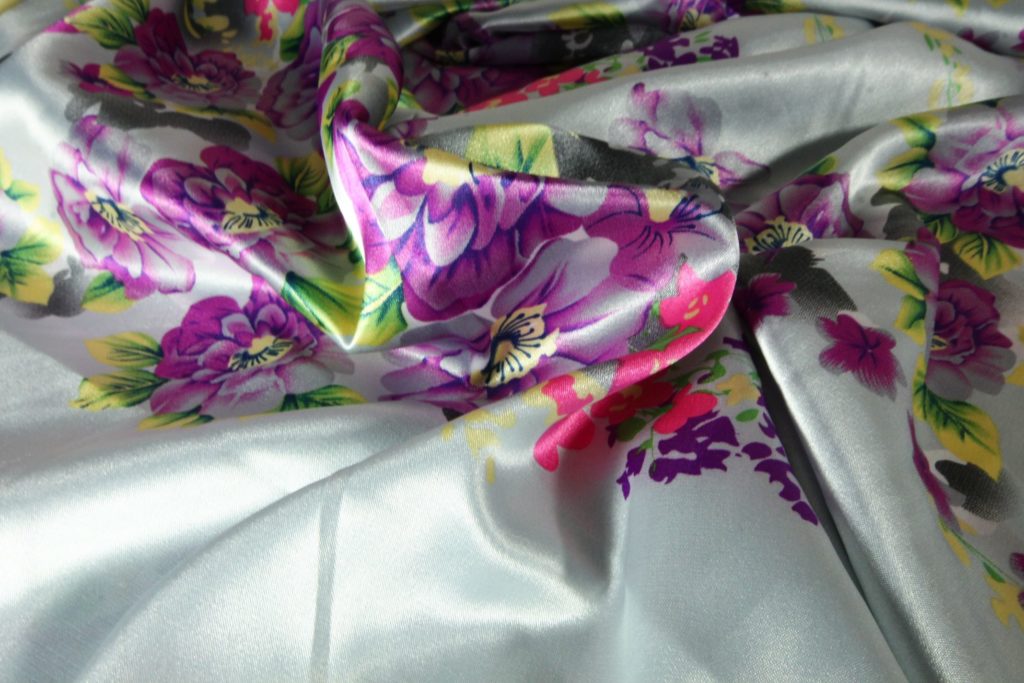Satin is a luxurious and rich fabric that was born 2 thousand years ago in China. The technology for producing this matter was so secret that anyone who tried to reveal it lost his life.
What is satin fabric
Natural satin is a fabric woven from natural silk threads, the front side of which is particularly smooth. In addition, it itself has the effect of a flowing surface, which makes it an easily recognizable material.

Synthetic or mixed satin is a completely synthetic or semi-synthetic product in which the threads are partially or completely replaced by artificial or natural ones, but simpler in their characteristics, for example, viscose.
It can be either plain or colored, that is, with a printed design.
Patterned material comes in the following types:
- Printed;
- Embroidered;
- Jacquard;
- Embossed.
From the name itself, it becomes clear how the design is applied to the surface of the fabric.
In addition, at the moment, it is worth noting that not only satin is available for sale, but also a large number of materials made from mixed fibers, but having a similar appearance:
- Satin;
- Duchess;
- Crepe satin;
- Taffeta;
- Crash et al.
Each of them has its own characteristics and distinctive features, and also has its own purpose.

The main characteristics of the atlas include:
- Festive look;
- Combination of density, elasticity and strength;
- Absolutely not transparent;
- It is quite heavy, so it sags in the product and drapes easily;
- Does not wrinkle;
- Has hygroscopic and antistatic properties;
- Hypoallergenic.
Among the negative properties are:
- Subject to shrinkage when exposed to heat;
- Subject to deformation;
- Fabric is difficult to sew because it always tends to slip away;
- The cut edge crumbles.
History of fabric, how it is made
The birthplace of the atlas is China. In this country, for the first time, by unwinding the cocoon of the silkworm by textile craftsmen, the finest thread was obtained, the price of which reached fabulous sums. In addition, the manufacturing process itself was very labor-intensive. This created a situation in which the availability of the atlas was so limited that it ended up only in the homes of the most noble and wealthy people in the world. It was also necessary to have the same position in society in order to be able to purchase a piece of outlandish fabric.

But with the advent of the industrial boom and the flourishing of the chemical industry in the 20th century, it became possible to produce artificial silk thread, which served as the basis for the creation of synthetic satin. This is how artificial silk and satin entered the masses.
In the production of this material, two types of weaving are used:
- Satin;
- Satin.
When weaving, the result is an overlap in which the warp thread completely covers the weft thread and is released onto the front side. As a result, a glossy surface is formed on one side of the fabric, while on the other, a rough surface is formed.
Today they produce mixed fabrics. They have one thread - a natural silk warp thread, while the weft thread, on the contrary, is taken simpler, for example, cotton, because it will be practically invisible from the outside.
Description, composition

The composition of modern satin fabric may include other, both natural and synthetic fibers:
- Viscose - reduces the cost of the product.
- Cotton – imparts a certain strength, which is reduced by the addition of viscose and acetate.
- Acetate - allows you to improve the appearance of fabric to which other fibers have been added.
- Elastane – used in fabrics with a stretch effect.
- Nylon – gives rigidity and elasticity to the fabric.
- Polyester - makes the fabric more flexible and flowing.
Synthetics, although they made the satin more accessible, still worsened a number of its qualities, such as:
- Moisture permeability;
- Air permeability;
- High aesthetic performance.
Application

Today the atlas has become very widespread:
- Bed sheets.
- The decor includes pillows, capes, curtains, lampshades.
- Gift packaging.
- Accessories – gloves, hats, ribbons, belts.
- And of course, clothes - from classic blouses to elegant evening or wedding dresses.
Whatever the use of the atlas, it definitely attracts attention. And it makes the owner of clothes made from such material feminine and elegant.


 1
1





